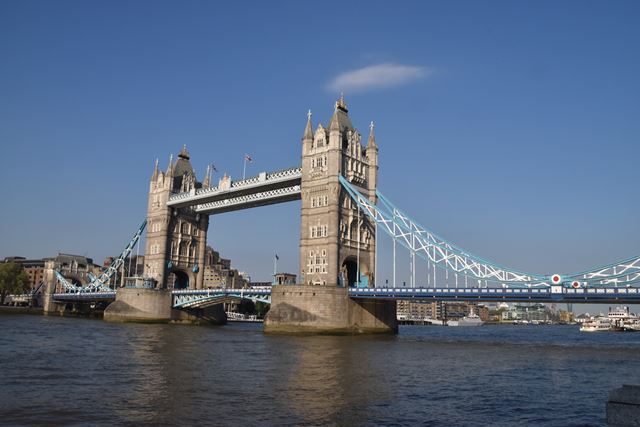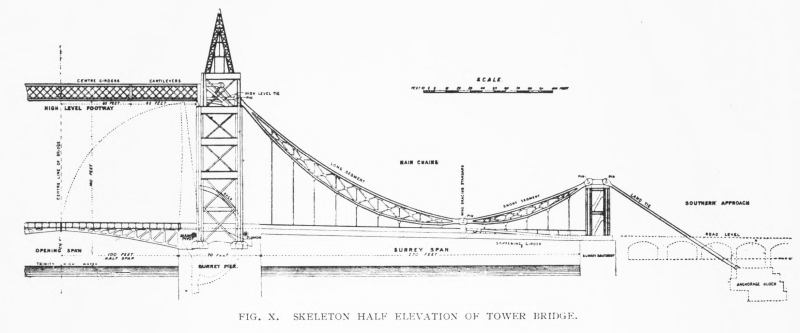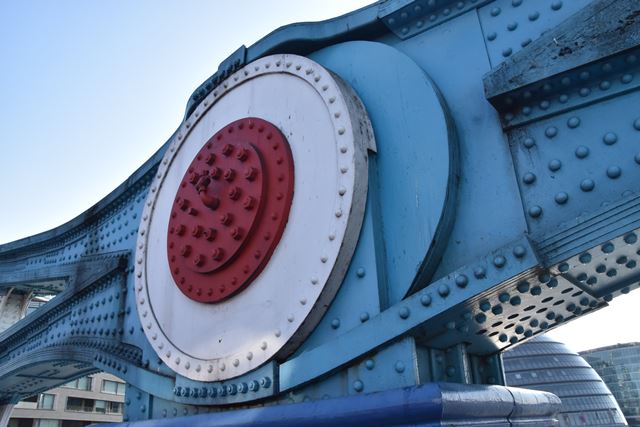We Recommend:
Bach Steel - Experts at historic truss bridge restoration.
BridgeHunter.com Phase 1 is released to the public! - Visit Now
Tower Bridge

Primary Photographer(s): Nathan Holth
Bridge Documented: May 9, 2018
London: Greater London, England: United Kingdom
Metal Rivet-Connected Pratt Deck Truss, Movable: Double Leaf Bascule (Fixed Trunnion) and Approach Spans: Metal Suspension, Fixed
1894 By Builder/Contractor: Sir William Arrol and Company of Glasgow, Scotland and Engineer/Design: John Wolfe Barry
1977
100.0 Feet (30.5 Meters)
880.0 Feet (268.2 Meters)
21 Feet (6.4 Meters)
1 Main Span(s) and 2 Approach Span(s)
Not Applicable

View Information About HSR Ratings
Bridge Documentation
View Historical Lecture By John Wolfe Barry
View Historical History of The Tower Bridge
View Historical Book About The Tower Bridge
The Tower Bridge is one of the most famous bridges in the world. Beyond its fame as an iconic symbol of London, it is also significant for its incredibly unique design and architectural detailing which includes an unusually configured braced suspension approach spans, a main bascule span, and an overhead walkway above the bascule. The bridge is also notable as the first "modern" bascule bridge. This bridge's fixed trunnion bascule design was the inspiration for engineers for the city of Chicago, Illinois who adapted the core design of the bascule span for their use and went on to build more bascule bridges in the city than can be found in any other city in the world. Indeed, the fixed trunnion bascule became one of the top two types of bascule bridge in the world (with the rolling lift being the other popular type). Fixed trunnion bascule bridges continue to be built today.
Please refer to the historical texts above for a more complete and detailed discussion of this bridge.
HistoricBridges.org is proud to offer large photo galleries for this bridge. The detail gallery is of particular note, since while this may be one of the most-photographed bridges in the world, many visitors may not stop to consider the intricate details of this bridge. Photo-documentation of these overlooked details was the goal of the gallery. Currently the galleries do not include photos from the inside of the upper walkway, or the interior of the machinery and accumulator rooms, which are open for public tour during business hours.
While the UK is well-known for taking excellent care of its historic bridges, the Tower Bridge is particularly remarkable. As of 2018, despite the heavy traffic this bridge sees, the historic integrity is outstanding. Even parts of the bridge one might expect to be replaced and modern remain of riveted construction and thus are either original or at least many decades old. There was no evidence of widespread replacement of rivets with bolts. There was no evidence of major pack rust or section loss in the steel. Even the deck stringers on the bridge are riveted (original?).
Above: This historical drawing shows the fixed trunnion design of the bascule span. The toothed rack is hidden within the main towers of the bridge. The trunnion is labeled as the "main pivot."
Above: A photo showing the bridge in its raised position. Photo Credit: Mvkulkarni23, CC BY-SA 3.0
Official Heritage Listing Information and FindingsListed At: Grade I Discussion: List Entry Number: 1385980 and 1357515 |
![]()
Photo Galleries and Videos: Tower Bridge
Structure Overview
Original / Full Size PhotosA collection of overview photos that show the bridge as a whole and general areas of the bridge. This gallery offers photos in the highest available resolution and file size in a touch-friendly popup viewer.
Alternatively, Browse Without Using Viewer
![]()
Structure Details
Original / Full Size PhotosA collection of detail photos that document the parts, construction, and condition of the bridge. This gallery offers photos in the highest available resolution and file size in a touch-friendly popup viewer.
Alternatively, Browse Without Using Viewer
![]()
Structure Overview
Mobile Optimized PhotosA collection of overview photos that show the bridge as a whole and general areas of the bridge. This gallery features data-friendly, fast-loading photos in a touch-friendly popup viewer.
Alternatively, Browse Without Using Viewer
![]()
Structure Details
Mobile Optimized PhotosA collection of detail photos that document the parts, construction, and condition of the bridge. This gallery features data-friendly, fast-loading photos in a touch-friendly popup viewer.
Alternatively, Browse Without Using Viewer
![]()
Maps and Links: Tower Bridge
Coordinates (Latitude, Longitude):
Search For Additional Bridge Listings:
Additional Maps:
Google Streetview (If Available)
GeoHack (Additional Links and Coordinates)
Apple Maps (Via DuckDuckGo Search)
Apple Maps (Apple devices only)
Android: Open Location In Your Map or GPS App
Flickr Gallery (Find Nearby Photos)
Wikimedia Commons (Find Nearby Photos)
Directions Via Sygic For Android
Directions Via Sygic For iOS and Android Dolphin Browser
Ordnance Survey Maps (UK Only)





